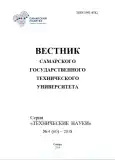Структура и алгоритмы функционирования систем измерения радиальных зазоров с самокомпенсацией температурных воздействий
- Авторы: Белопухов В.Н.1, Боровик С.Ю.1, Кутейникова М.М.1
-
Учреждения:
- Федеральное государственное бюджетное учреждение науки Институт проблем управления сложными системами Российской академии наук
- Выпуск: Том 26, № 4 (2018)
- Страницы: 52-65
- Раздел: Приборостроение, метрология и информационно-измерительные приборы и системы
- URL: https://journals.eco-vector.com/1991-8542/article/view/21284
- DOI: https://doi.org/10.14498/tech.2018.4.%25u
- ID: 21284
Цитировать
Полный текст
Аннотация
Статья посвящена принципам построения систем измерения радиальных зазоров в компрес-сорах газотурбинных двигателей, реализующих метод измерения на основе применения одно-виткового вихретокового датчика с чувствительным элементом в виде отрезка проводника и самокомпенсацией температурных воздействий на датчик. Метод предполагает использо-вание всего одного одновиткового вихретокового датчика, выполняющего как рабочие, так и компенсационные функции при единственном установочном отверстии в статорной оболочке силовой установки. Самокомпенсация осуществляется в рабочем режиме в процессе враще-ния рабочего колеса газотурбинного двигателя путем измерения и фиксации экстремальных значений эквивалентной индуктивности первичной обмотки согласующего трансформатора одновиткового вихретокового датчика при наличии контролируемой лопатки как в зоне чув-ствительности датчика, так и при ее отсутствии (т. е. при прохождении чувствительного элемента центром межлопаточного промежутка) с последующим вычислением разности по-лученных результатов. Полученная разность не зависит от температурных воздействий на элементы конструкции датчика. Благодаря такой самокомпенсации отпадает необходи-мость в дополнительном датчике, традиционно используемом для термокомпенсации, а зна-чит, и соответствующем установочном отверстии в статорной оболочке. Это и определяет преимущества предлагаемого метода по сравнению с известными. В статье рассматривает-ся обобщенная структурно-функциональная схема системы измерения, реализующей указан-ный метод, а также приводятся основные алгоритмы ее функционирования, включая алго-ритмы поиска экстремальных значений кодов в межлопаточном промежутке, вычисления разностных кодов и устранения недокомпенсации температурных воздействий на датчик, а также идентификации номеров лопаток рабочего колеса при асинхронном опросе первичных преобразователей.
Об авторах
В. Н. Белопухов
Федеральное государственное бюджетное учреждение науки Институт проблем управления сложными системами Российской академии наук
Автор, ответственный за переписку.
Email: info@eco-vector.com
Россия
С. Ю. Боровик
Федеральное государственное бюджетное учреждение науки Институт проблем управления сложными системами Российской академии наук
Email: info@eco-vector.com
Россия
М. М. Кутейникова
Федеральное государственное бюджетное учреждение науки Институт проблем управления сложными системами Российской академии наук
Email: info@eco-vector.com
Россия
Список литературы
Дополнительные файлы







